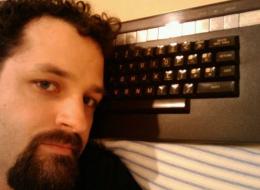This website is an archive of some of the more interesting or amusing
bits of software I wrote for the
In 2013, I browsed the contents of ~200 5.25" floppy disks that are
in my possession. Many were disks from my childhood, that my father had in
storage, and had given back to me a few years prior. I stuck Post-It
notes on the disks with interesting content that I wanted to share.
I also took

I'm Bill Kendrick, a software developer by profession & hobby.
My day jobs have included lots of web application development, and
some mobile game development. Since 2008, I've been CTO of
As a hobby, I've developed a number of games and other applications
as
When I had much more free time, I maintained the
Atari 8-bit New User, Emulator Help FAQ
and spent more time taking care of
Since 2009, I've also run a semi-annual
Since I was just a kid in the mid-1980s, I'm not what you'd call a
"published software developer" for the Atari. Don't expect
My first computer was a
In 1986, I begged my parents to spend $150 on an

There's my high school senior portrait from 1992, as rendered on my Atari in ColorView 9 mode (80x192, 4096 colors).
The best game I wrote for the Atari was
A few years later, I received an unexpected package from
Today,
I'm not sure that you should! My main motivation is to archive what
was on my old disks. ("Real men just upload their important stuff on ftp,
and let the rest of the world mirror it"
–
On the other hand, it could be that archivists
(hi, Jason!) or researchers
might find it interesting to see into the mind of a computer nerd from
the 1980s. (See also:
A few reasons:
DOS.SYS
and DUP.SYS) on them, and places them on an
SIO2SD device I use for
storage on my Atari nowadays. For some reason, it decided to show me the
directory of blank ATR disk images in random order, so I just went with it.It depends! I've done my best to explain what each file is, since as
a kid I named things erratically, and typically without following
conventions. e.g., ".COL" is a tokenized BASIC program
(normally named ".BAS", but it's for the stuff I thought
was "cool". Sometimes I left filename extensions off, altogether,
or I used them to extend the name of the file (e.g.,
"SUPERMAR.IO")
It's best to run these with standard Atari BASIC. Some things may be usable with TurboBASIC XL, but typically games will be unplayably fast.
- Run with BASIC enabled. (My development system during most of my programming childhood was a 64KB Atari 1200XL with a revision B (ugh!) Atari BASIC cartridge. Other XLs and XEs typically had built-in BASIC, which is enabled by default.)
- Boot into the disk image; they contain MyDOS 4.53/4. You'll land at the BASIC "
READY" prompt.- Load an run the file marked "Loader", e.g.:
RUN "D:GAME"
There may be an intro screen. Typically, it will load one or more fonts into memory, which the game will require. Often, this takes a while (using a "FOR" loop with "GET" from disk, and "POKE" into RAM).- It will then automatically load and run the game. Usually, firebutton on the joystick, or Start on the Atari, will begin the game. Sometimes there are options. YMMV.
As above, use BASIC. Just load and run the program, and it will do any setup it needs to, and begin the game. e.g.:
RUN "D:COOLGAME.COL"
These require TurboBASIC XL; they will not run in Atari BASIC, as they utilized the extra features (and, of course, speed) of TBXL. As above, load and run the file marked "Loader", e.g.:
RUN "D:X.TBS"
Again, this will load fonts and any other data into RAM, and then load and run the main program. This should be much faster than the older BASIC games' loaders, as it uses TBXL's "BGET" to quickly load large chunks of data from disk.
As above, just load and run the program, e.g.:
RUN "D:GAMEX.TBS"
Often, my Action! programs get large, so I break them up into a main
file (which gets compiled directly), and "included" files.
Sometimes, having any data in Action!'s editor will leave too little
space for compiling the program, so you may need to compile it
from the Action! monitor, e.g.,
"C SOMEFILE.ACT
Boot with BASIC disabled (e.g., hold Option during power-up). From MyDOS, [L]oad the binary file. (If it fails, maybe the particular executable requires Action! cartridge installed, as it was not compiled with a runtime package.)
Home | About | Email Bill